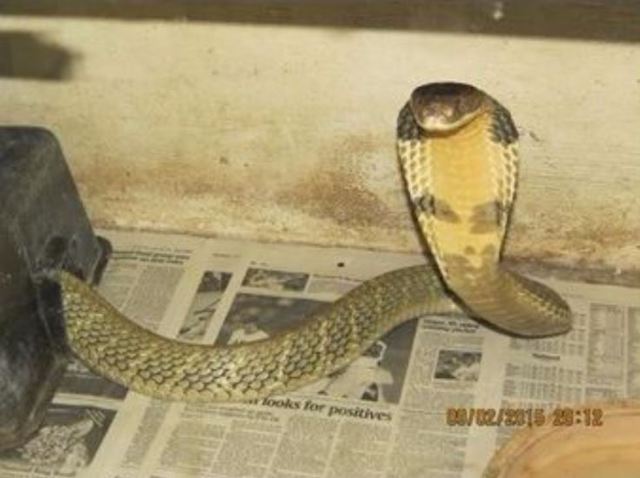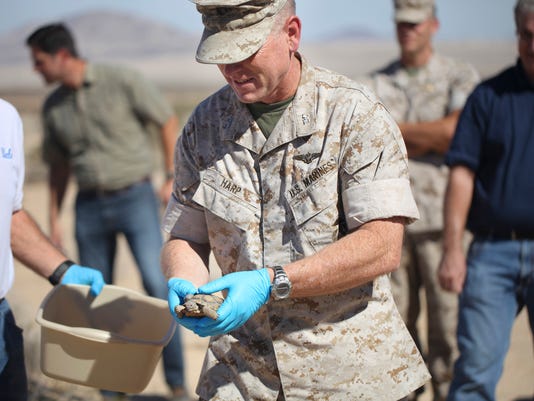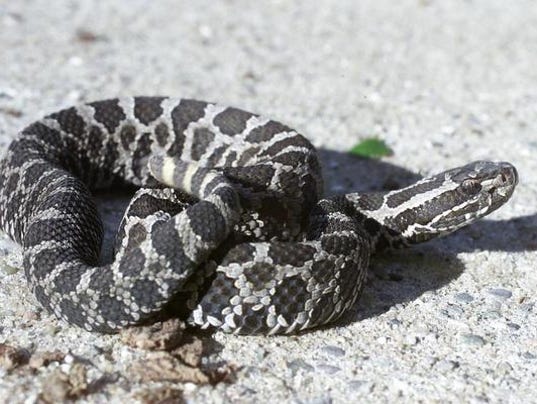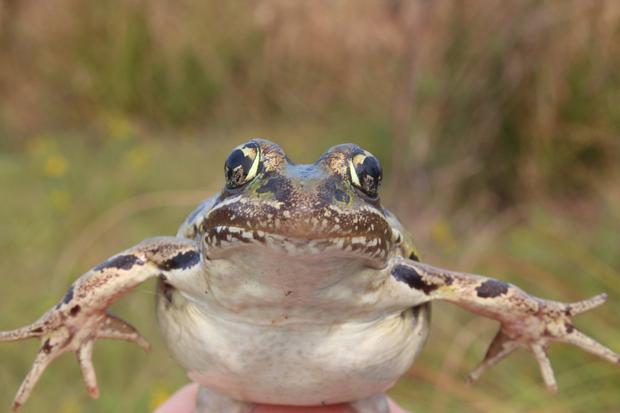Reptile & Amphibian
News Blog
Keep up with news and features of interest to the reptile and amphibian community on the kingsnake.com blog. We cover breaking stories from the mainstream and scientific media, user-submitted photos and videos, and feature articles and photos by Jeff Barringer, Richard Bartlett, and other herpetologists and herpetoculturists.
Wednesday, October 14 2015

This amazing looking cultivar is a Super Genetic Banded Paradox Albino Ball Python ( Python regius). I had the honor of hatching the first example of this new morph earlier in 2015. People who know me and follow my posts here, on my site, and on social media are aware that I have been hatching a whole lot of Paradox Ball Pythons, especially Paradox Albinos. Friends joke that I must be putting something in my water, but the fact is that after many years and much effort I have hopefully made an advance in how to produce Paradox Ball Pythons.
The Paradox Gene is not fully understood and I am not trying to claim that I fully understand it. What I am saying is that results speak for themselves and that it took more than luck for me to produce Paradox Albinos and other Paradox Ball Python Morphs every year for the past 5! I expect to hatch more in 2016 barring thermostat or incubator malfunctions!
What a great shot of this clutch of subocs in our herp photo of the day uploaded by kingsnake.com user pecoskid ! Be sure to tell them you liked it here!

Upload your own reptile and amphibian photos at gallery.kingsnake.com, and you could see them featured here!

Photo: A photo obtained from the Christian-Albrechts-Universitat of Kiel shows a South-American horned frog (genus Ceratophrys), waiting for its prey
Read more at: http://phys.org/news/2014-06-super-sticky-frog-scientists-tongue-tied.html#jCp
It was previously thought that a frog's tongue got it's stickiness from the saliva, but recent research suggests something completely different.
"The experimental data shows that frog tongues can be best compared to pressure-sensitive adhesives that are of common technical use as adhesive tapes or labels," according to the study published in the journal Scientific Reports.
Read more on this study at Phys.org.
Tuesday, October 13 2015
Everyone feels just like this little chameleon does here in our herp photo of the day uploaded by kingsnake.com user 1Sun every once in a while! Be sure to tell them you liked it here!

Upload your own reptile and amphibian photos photos at gallery.kingsnake.com, and you could see them featured here!

Photo: The News-Press
University of Queensland has decided turtles look good in clothes. They have altered the design of rash vest to fit both hatchling and adult sea turtles to learn a bit more about the dietary needs of Loggerheads by collecting a full fecal sample.
Mr Coffee said the information could be used to identify and protect habitats.
"The idea is that I'll be sampling nesting females as well," he said.
"So I'll be taking blood and skin from nesting females over the summer period at Mon Repos and Heron Island and be hoping to use ... analysis on those and figure out where they were foraging before they came to nest.
To get the full poop on this article, visit ABC.net.

The red pygmy rattlers of Hyde County, NC are among the world's most beautiful snakes.
It was exactly 5:45PM and the temperature was 84F when we turned from the pavement onto a secluded dirt road in Hyde County, NC. It was a sunny mid-August afternoon and the humidity was high. Moments earlier we had photographed a 4-foot long canebrake rattler lying quietly in the then traffic free oncoming lane, but it was not for canebrakes that Jake and I had made the drive. Rather, it was the hope of seeing a red phase Carolina pygmy rattlesnake, Sistrurus m. miliarius, that had drawn us northward those several hundred miles. We had allowed 2 nights for the search.
Within 15 minutes of finding the canebrake we were back in the car. Decision time was upon us. Should we remain on the sun-warmed paved road or turn onto the cooler, shaded intersecting dirt road that stretched off far into the distance. The dirt road won out and it proved to be a good decision. Within five seconds of having made the turn we found the target, a beautiful adult red phase pygmy. It lay fully stretched just inches from an acre of tall grasses. Indeed the deities of herping were smiling on us! We had found our main target on the first evening and could now concentrate on our newly stated target 2 the next night. From this, the Sandhills phase of the Carolina pygmy, we were separated by several hundred miles. But at least the destination was closer to home. Have I ever mentioned how big the Carolinas seem when driving east to west?
Continue reading " Red Pygmy Rattlesnakes"
Monday, October 12 2015

Isn’t this Jungle Carpet Python crazy looking?! It is one of a kind and a Super Form from what the Ball Python Crowd refers to as a, “Dinker Project.”
I noticed that the mother of this snake looked just a bit odd when it was a baby. I bought her, bred her, and then bred one of her male offspring back into her to get a super form of the co-dominant gene that she carried. I know a lot of kingsnake.com users attend Reptile Shows so I will share my story about buying the mother of this snake.
All morning long I was busy at this show vending at my table and I was unable to make a round until around lunch time. When I arrived at one of the better Carpet Python vendor tables there was a crowd standing around looking at a baby JCP in a deli cup marked $350.00. They were all commenting under their breath about the little snake, but for me there was no discussion. I peeled off the cash, handed it to the vendor, and then picked up the cup with the snake.
All the guys said, "WHOA!! I was thinking about buying that” . The vendor looked at me and said, “That snake will turn out to look normal and so will all the babies.” I made two replies. To the crowd I responded, “You can keep thinking about buying it, but I just bought it.” To the vendor I said, loud enough for all to hear, “If this $350 female JCP turns out to be normal I will more than break even selling her normal babies.” There are lessons to be learned in all of this but don’t ask me what they are. I am just trying to have fun and I am relegated to but one of these crazy looking JCP after about 10 years of effort.

Photo: Robin Moore/ILCP
Called the "Golden Wonder" by conservationists, the Jackson’s Climbing Salamander, Bolitoglossa jacksoni, has not been seen since 1977. This field report chronicles the search for the Golden Wonder, as well as many other great and rare amphibian finds.
“When I spied that oh so familiar pose of a Long-limbed Salamander basking in the rain with feet splayed and spine bent with that beautiful long tail hanging down, I was thrilled. It really brought back much of what it had been like in ‘76; going out night after night in the rain. Finding this salamander is as rewarding as it was years ago.”
To read the full account, visit National Geographic.
This sassy lil watersnake had to stop and eat a toad in the yard before the photographer captured it for our herp photo of the day uploaded by kingsnake.com user dinahmoe ! Be sure to tell them you liked it here!

Upload your own reptile and amphibian photos photos at gallery.kingsnake.com, and you could see them featured here!
Friday, October 9 2015
Happy Rattlesnake Friday! We are seeing red with this gorgeous shot of a Pygmy Rattlesnake our herp photo of the day uploaded by kingsnake.com user Tamers1 ! Be sure to tell them you liked it here!

Upload your own reptile and amphibian photos photos at gallery.kingsnake.com, and you could see them featured here!
Thursday, October 8 2015

We occasionally see adult Florida rough green snakes in the cat briars along the fencelines.
I was creeping along on the riding mower a few afternoons ago when just ahead of the right front tire I notices a lengthy piece of grass make a shivery-sinuous movement. Hmmmmm. Either the grass was reacting in a frightened manner at the thought of being decapitated by the whirling blades or there was something there that needed scrutinizing. Choosing the latter of these 2 options I slammed on the brakes, crawled from the seat, moved a step ahead of the idling machine, stooped down and saw----nothing! I stood, was just about to hop back on the mower when I happened to see a little pink tongue flickering. Once the tongue was seen the rest of the creature, all 7 inches of it (a hatching Florida rough green snake, Opheodrys aestivus carinatus wonderfully camouflaged by the grass blades) was easily seen. I was sure glad I had stopped.
Over the years I had seen several adult rough green snakes amidst tangles of cat briar, blackberry canes, and Virginia creeper along the fence line, but this was the first hatchling I had seen in the yard. I sure hope it will not be the last.
Click below for more pictures
Continue reading "Rough Greens"

A missing King Cobra that went on walkabout over a month ago has turned up underneath a clothes dryer at a neighbors house a half mile from it's cage. Found Wednesday night Orange County Animal Control officials and the wife of the snake’s owner confirm the snake is the one that escaped 35 days ago and it has been returned to its owners.
“Every time I put something in the dryer this hiss sound happened.” - Cynthia Mullvain
The cobra’s owner, Mike Kennedy, is facing charges for failure to immediately report the escape and has pleaded not guilty.
To read more check out the article at http://wfla.com/2015/10/08/missing-king-cobra-snake-found-in-orange-county-home/

Just days after capturing the once-missing king cobra from a local garage, Florida wildlife officials on Friday confirmed their intent to revoke the owner's license to own the venomous snake in a revocation letter, sent a day before the king cobra was captured. "Allowing you to continue to possess your venomous reptiles after three escapes would send a message that there will be no consequences for serious rule violations,"
The owner of the cobra has held permits to keep various exotic and potentially deadly animals for years, but records show numerous violations for not properly containing the animals including being cited in 2001 after another king cobra escaped from a house in the College Park area of Orlando, and in 2004 when an albino diamondback rattlesnake escaped and ended up in a neighbor's yard.
Read more at the Orlando Sentinel
Is there any thing more classic than this chameleon tongue shot in our herp photo of the day uploaded by kingsnake.com user 1Sun ! Be sure to tell them you liked it here!

Upload your own reptile and amphibian photos photos at gallery.kingsnake.com, and you could see them featured here!
Wednesday, October 7 2015

Photo: Lauren Kurkimilis/Marine Corps via AP
Near Twentynine Plams Marine Corps Base, 35 Desert Tortoises were recently released in an effort to repopulate the Mojave Desert at a ceremony with Marine Corps officials, U.S. Fish and Wildlife Service, California Department of Fish and Wildlife, and researchers from the University of California Los Angeles.
Biologists have been raising tortoises over the past nine years at a six-acre facility to help boost the population that was nearly decimated by a respiratory virus in the late 1980s.
Read more at Marine Corps Times.
This great shot of a pair of Bufo bufo in the middle of amplexus helps ring in this Wednesday in our herp photo of the day uploaded by kingsnake.com user Krallenfrosch ! Be sure to tell them you liked it here!

Upload your own reptile and amphibian photos photos at gallery.kingsnake.com, and you could see them featured here!
Tuesday, October 6 2015

Note the difference in blotch size of these 2 Sandhill pygmys.
Back and forth. Back and forth. North 10 miles. South 10 miles. Than over again—and again. Occasionally we changed our route to an intersecting sand road for a few miles. We had only one night left on this trip and we were on a quest in unknown (for Jake and me) territory. The targets here were the sandhill phases of the Carolina pygmy rattlesnake, Sistrurus m. miliarius.
Although it hadn’t looked all that far on the map, I’m here to tell you it was a long drive from Hyde County NC to the sandhill region of northcentral SC! Once Jake and I had succeeded in finding and photographing a red phase pygmy in Hyde County, we had decided that in the remaining time we needed at least one more feasible target. Thus began the quest for sandhill pygs that found us now in the land of sand pines, cacti, thornscrub, fox squirrels, beautiful little pothole ponds (which, we were told were replete with broken-striped newts (of which we found exactly none!)—and the sandy countryside (again we were told) was acrawl with pygmy rattlers.
The afternoon waned, sunset neared, passed, and darkness enveloped us. Bats wheeled and darted in front and overhead and still we drove. We turned onto a paved side road, drove up a few miles and reversed direction. I looked at what seemed to me a black marked white stick at the road edge. Jake did a double take and hollered “STOP. Back up. That was a snake!”
And sure enough it was a little dark blotched silvery white pygmy, the first of 4 seen that night. Photos were taken and we headed southward. It had been a great trip. Thanks, Jake.
Continue reading "Sandhills Phase Pygmy Rattlers"
This stunning Trimeresurus vogeli is just hanging around in our herp photo of the day uploaded by kingsnake.com user Vittorio_K ! Be sure to tell them you liked it here!

Upload your own reptile and amphibian photos photos at gallery.kingsnake.com, and you could see them featured here!
Monday, October 5 2015

A python, reported to be 20 feet in length, critically injured a pet store owner in Newport Ohio in an apparent feeding mishap. According to media reports store owner Terry Wilkins was feeding the snake when it latched onto his arm and wrapped around his head, neck, and torso. Wilkens was not breathing when officers arrived to free him but he did resume breathing before he was taken to University of Cincinnati Medical Center.
"It was only by the grace of God that one of the officers knew how to deal with snakes," - police chief Tom Collins
The owner appears to be recovering after two officers pried off the 125-pound python that was wrapped around his head, neck and torso, according Collins.
The snake is currently alive and being held at the store where the incident occurred. Police are working with animal control to determine if the animal will need to be removed from the shop.
Click here to read more at WCPO Gallery photo by ahas

In what is likely to be the first of a number of reptilian additions the Black Pine Snake, Pituophis melanoleucus lodingi, has been added to the USFWS Threatened and Endangered Species List. Found in southwestern Alabama through southeastern Mississippi into eastern Louisiana, Black Pine Snakes are the only melanistic pine snake, ranging in coloration from an overall black and brown banded snake to a nearly jet-black animal. A threatened designation means a species is at risk of becoming endangered within the foreseeable future. The snake’s threatened status allows the USFWS to include exemptions allowing certain management activities to continue to occur with protection from the loss, injury or harassment.
“We crafted the exemptions to provide landowners flexibility to manage for their objectives while still affording conservation benefits to the black pinesnake,” - Cindy Dohner, USFWS Southeast Regional Director.
The Black Pine Snake’s decline is primarily attributed to the loss and degradation of the longleaf pine ecosystem because of habitat fragmentation, fire suppression, conversion of natural pine forests to densely stocked pine plantations, and agricultural and urban development. Other threats to the snake’s survival include road mortality and killing by humans.
The Black Pine Snake was added to the US Fish and Wildlife Services list of candidates for federal protection in 1999, and the Service published a proposed rule to list the black pinesnake as threatened on October 7, 2014. The black pinesnake final listing becomes effective on November 5, 2015 which is 30 days after its publication in the Federal Register on October 6, 2015. The decision is part of the Service’s effort to implement a court-approved settlement under an agreement aimed at significantly reducing it's current litigation-driven workload.
To read the USFWS Press Release click here. Gallery photo by user noMad627

Photo: Eric Sharp, Detroit Free Press
Despite being up for consideration of listing on the Endangered Species Act since 1999, the Eastern Massasauga has remained unprotected. Now it appears that will change. Known for their docile nature, the massasauga rattlesnake has it's greatest known population density in the state of Michigan, but as with most endangered species, habitat destruction has started putting extreme pressure on the current populations.
The biggest threat to the snake, across its range from Missouri to New York, is loss and degradation of habitat, Kingsbury said.
"The snakes don't travel as far as other animals do from habitat patch to habitat patch," he said. "Anytime you have paved roads, a farmer's field, a residential area, they will be barriers to the snake, and it will turn around and head back from where it came."
Read more at USAToday.com.
Is it any wonder that Bearded Dragons are still one of the most popular pets in the reptile community? Not when you see this cute guy in our herp photo of the day uploaded by kingsnake.com user JFKDragons ! Be sure to tell them you liked it here!

Upload your own reptile and amphibian photos photos at gallery.kingsnake.com, and you could see them featured here!
Friday, October 2 2015
A great shot of a live (as they should be) Pygmy Rattlesnake on concrete in the field in our herp photo of the day uploaded by kingsnake.com user JARHEAD1969 ! Be sure to tell them you liked it here!

Upload your own reptile and amphibian photos photos at gallery.kingsnake.com, and you could see them featured here!
Thursday, October 1 2015

This is an adult pair of Egyptian tortoises.
It was about 35 years ago when Chris invited me to check out a few tiny tortoises that he had just received. They were, he said, Egyptian tortoises, Testudo kleinmanni. I had to do some scrambling to familiarize myself with this taxon but I was able to learn that at an adult size of only 3.5 to 5" this was the smallest of the genus and that even in those days was considered a rarity. It had apparently once ranged from Libya to Israel but was thought to have been extirpated over much of its range.
Sadly, Florida proved an unsuitable home for these new arrived but aridland adapted arrivals. Although most survived here few actually thrived. In contrast, many of them that went to homes in the drier and less humid desert and prairie states seemed to do well and once the chelonians had been acclimated a number of hobbyists succeeded in breeding them one or more times.
But even today the availability of these little charmers is spotty at best. And although I have never maintained this taxon I have been told that the hatchlings produced from well acclimated captive adults are much hardier than those imports of long ago. I sure hope that this is the case and that future years will see this tortoise readily available to herpetoculturists.
More photos under the jump
Continue reading "The Egyptian Tortoise"

Photo Credit: Matthew Schlesinger, New York Natural Heritage Program
Carl Kauffeld believe there were two very different species of Leopard Frogs, but he did not have the means to prove it. Thankfully we now do! With the help of a geneticist, a team of researchers recently proved Kauffeld's belief to be true and named the Atlantic Coast Leopard Frogs after the herper great, Rana kauffeldi.
"There might have been some jumping up and down," recalled Dr. Matthew Schlesinger, the head of zoology at the New York Natural Heritage Program, who was part of the team. "There might have been some high fives going around."
...
Now, with virtually nothing known about this animal, the team trying to track and learn about its range and habits. "It's like we're trying to write the page of the field guide that's devoted to this species," Schlesinger said.
Learn more at WNYC.
This gorgeous closeup of a Painted Turtle also shows a bit of old fashion home grown cage decor in our herp photo of the day uploaded by kingsnake.com user trachemys ! Be sure to tell them you liked it here!

Upload your own reptile and amphibian photos photos at gallery.kingsnake.com, and you could see them featured here!
|



